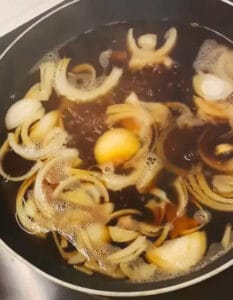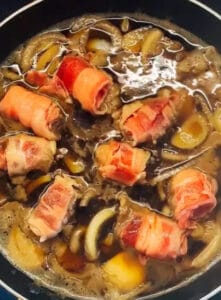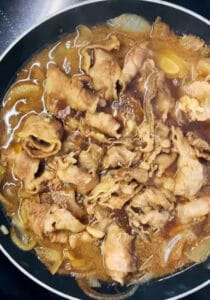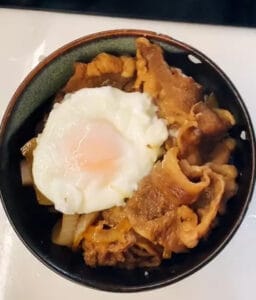Explore the delicious world of gyudon yoshinoya beef bowls with our step-by-step Gyudon Recipe Yoshinoya guide. Master the art of creating the perfect Japanese beef bowl at home, and savor the authentic flavors of this iconic dish with our expert tips and detailed instructions.
As a chef at Food And Meal I have a deep passion for creating delicious barbecue dishes that bring warmth and comfort to the people in my community. However, my recent travels to Japan opened my eyes to an entirely different cuisine that spoke to my soul – the simple yet profoundly satisfying gyudon, or Japanese beef rice bowl.
The first time I took a bite of the thinly sliced, tender beef and sweet onions simmered in a savory mirin and soy sauce, the flavors and textures ignited my senses. I was transported back to my childhood when my grandmother would cook soulful stews, brimming with love. As I savored each morsel over the perfectly steamed Japanese rice, a feeling of nostalgia and home washed over me.
I knew then that I needed to learn how to make authentic Gyudon Recipe Yoshinoya to share with my family and customers back home. Through trial and error in my test kitchen, I finally developed my own yoshinoya beef bowl recipe – an homage to the Japanese classic with my Southern barbecue twist. I caramelize the onions in brown sugar to accentuate their natural sweetness before deglazing the pan with a splash of bourbon. The alcohol cooks off, leaving behind its oaky, vanilla notes that mingle beautifully with the mirin, soy and ginger.
As I plate the steaming bowl of my reimagined gyudon beef bowl, the memories of my travels fill my heart once more. I can’t wait for you to experience the magic of this dish and how it will transport you as well. Now dig in, y’all!
Best Gyudon Recipe Yoshinoya
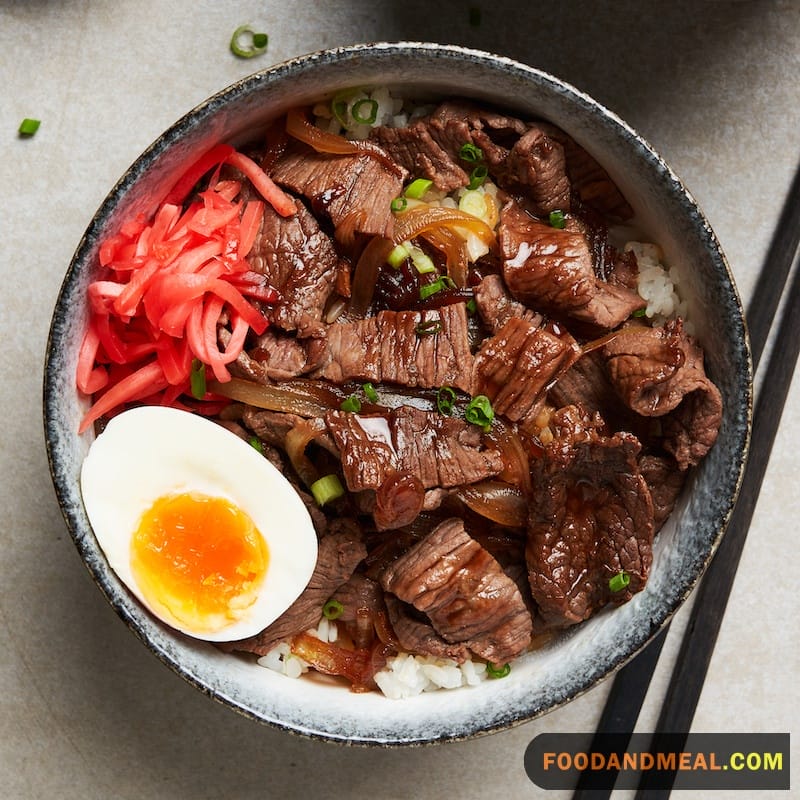

Gyudon Recipe Yoshinoya - Beef Rice Bowl
Ingredients
- 7 ounces beef sliced into thin strips or bite-sized pieces
- 1 small onion sliced thickly (about ½ inch)
- 1-2 servings steamed rice freshly cooked
For sauce
Toppings (optional)
- Red pickled ginger or beni shoga
- Seven spice powder or shichimi togarashi
Instructions
- Combine the sauce ingredients in a saucepan and bring it to a boil. Add the onions and cook for 1 minute.

- Add the beef. Reduce the heat and let it simmer until the beef is done (about 10-15 minutes). Let it cool to develop the flavors, and then reheat (skip this step if you’re in a hurry).

- Pour over the prepared rice and add your choice of toppings (optional).

- Enjoy it!

Video
Notes
Nutrition
© Food And Meal
This website provides approximate nutrition information for convenience and as a courtesy only. Nutrition data is gathered primarily from the Spoonacular Database, whenever available, or otherwise other online calculators.
Making Gyudon Japanese Beef in a Rice Cooker

Ingredients:
- 1 pound (450g) thinly sliced beef (sukiyaki or shabu-shabu cuts)
- 2 large onions, thinly sliced
- 1/4 cup soy sauce
- 2 tablespoons mirin (sweet rice wine)
- 2 tablespoons sake (Japanese rice wine)
- 2 tablespoons sugar
- 1 1/2 cups dashi stock (use a dashi pack or powder)
- 1 tablespoon vegetable oil
- 4 servings of cooked Japanese short-grain rice
Instructions:
- Start by rinsing your rice and setting it to cook in your rice cooker. Follow the manufacturer’s instructions for the quantity of water needed.
- While the rice is cooking, heat a large pan on the stovetop. Add the vegetable oil and sliced onions. Cook over medium heat until the onions become translucent and soft.
- Push the onions to the sides of the pan, creating space in the center. Place the thinly sliced beef in the center and let it cook for a minute or two until it starts to change color.
- In a separate bowl, mix together the soy sauce, mirin, sake, and sugar. Pour this mixture over the beef, and stir gently. Allow it to simmer for a couple of minutes.
- Once the beef is cooked and the sauce has thickened slightly, add the dashi stock to the pan. Let it simmer for another 2-3 minutes.
- By this time, your rice cooker should be finishing up. When the rice is ready, divide it into four bowls.
- Spoon the Gyudon beef and sauce over the rice in each bowl.
- Your japanese beef bowlis now ready to be served. You can optionally top it with beni shoga (pickled ginger) or a sprinkle of shichimi togarashi (Japanese seven-spice blend) for an extra kick.
Tips and Tricks
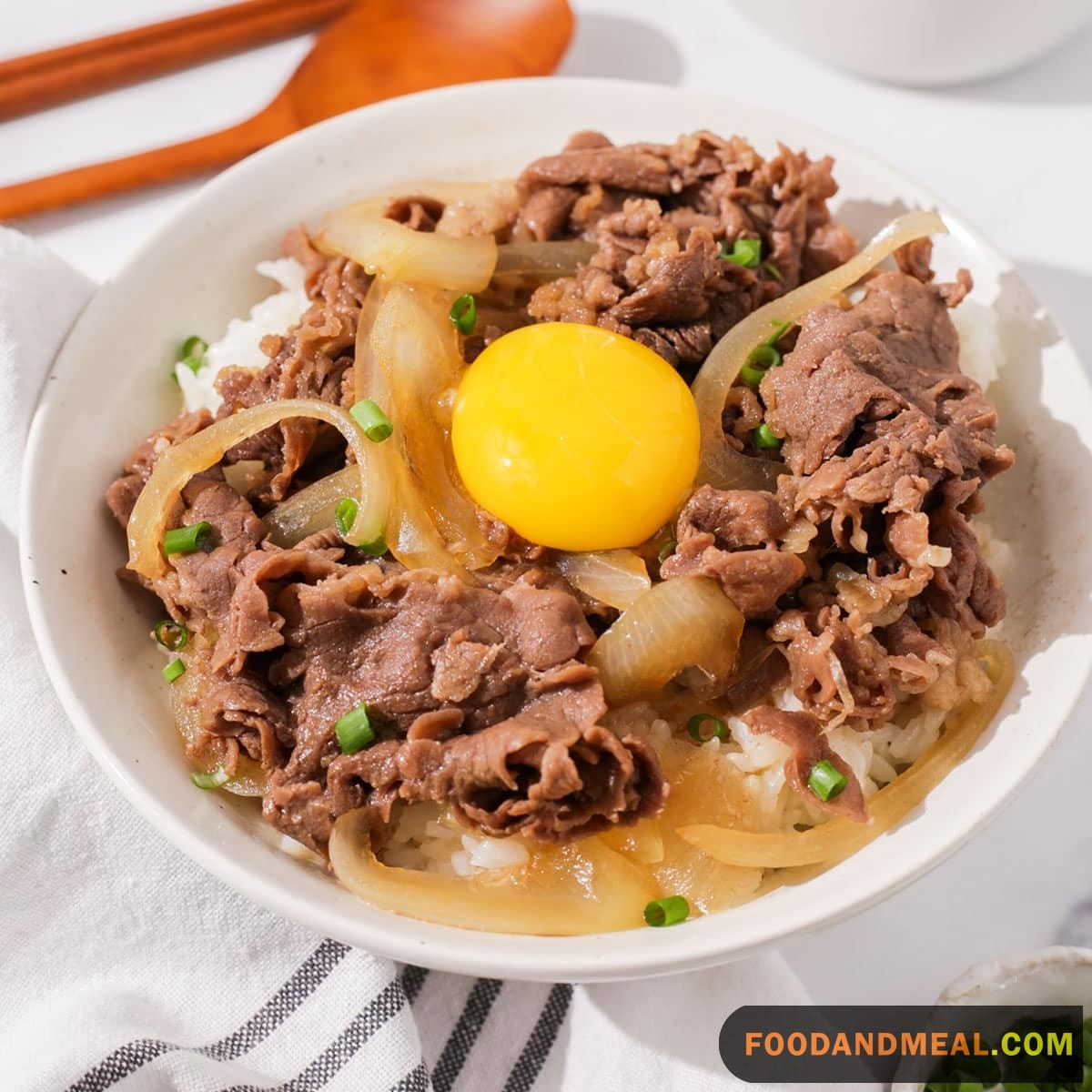
Cooking Tips for Perfect Gyudon Recipe Yoshinoya
Tips and Tricks for Success:
- Use thinly sliced beef: Gyudon is all about the thin slices of beef, so make sure you choose the right cut. Look for sukiyaki or shabu-shabu cuts, readily available in Japanese or Asian grocery stores.
- Slow and steady: When simmering the beef in the sauce, take your time. Let it soak up those delicious flavors for a more mouthwatering result.
- Don’t overcook the beef: The beef slices should be tender and slightly pink when you add them to the onions. Overcooking can make them tough.
Common Mistakes to Avoid:
- Adding too much liquid: Be cautious with the dashi stock. Adding too much can make your Gyudon recipe Yoshinoya too soupy. Adjust to your preferred consistency.
- Neglecting the onions: Onions are a crucial component. Cook them until they’re soft and sweet to enhance the overall flavor.
- Skipping the dashi: Dashi stock provides the essential umami flavor. Don’t substitute it with plain water; it won’t be the same.
Serving Suggestions for Gyudon japanese beef bowl
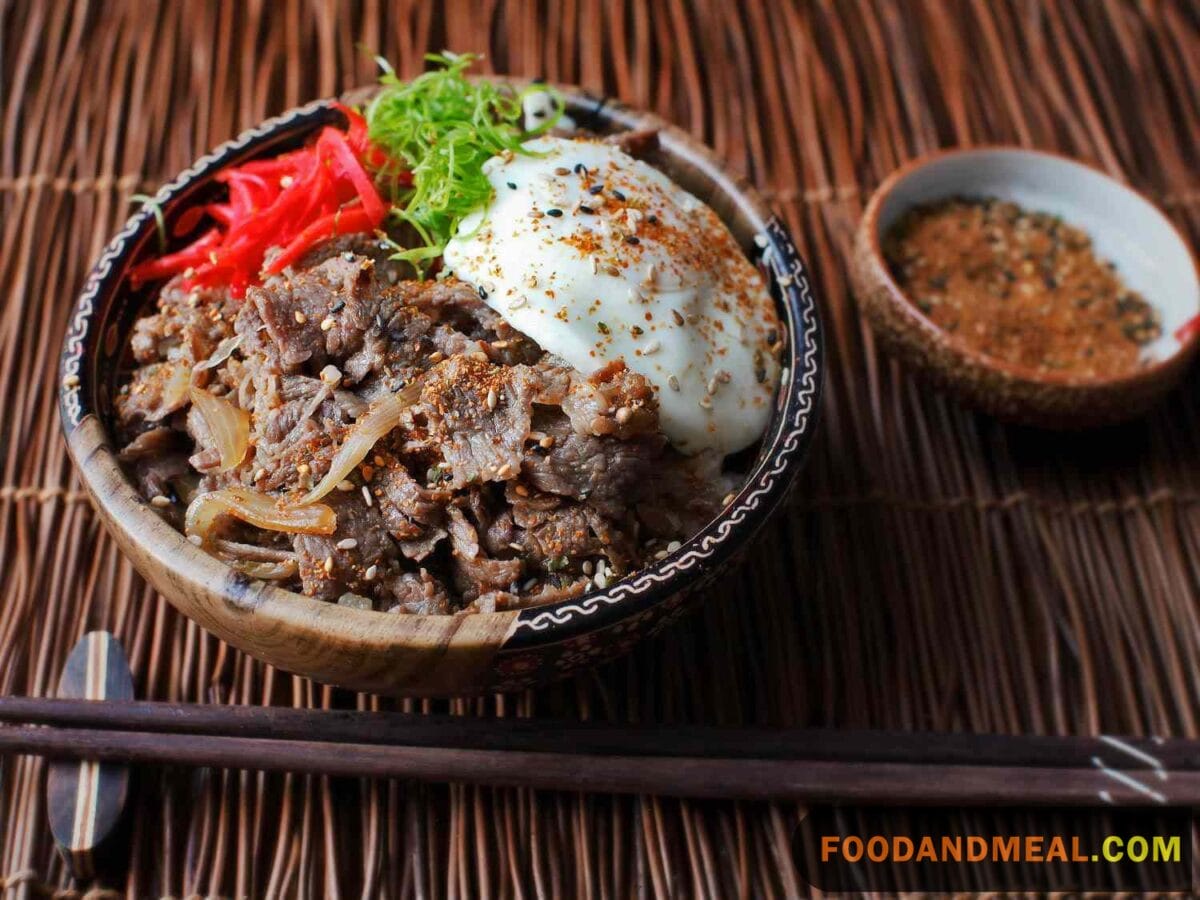
Japanese beef bowl, with its thinly sliced beef and sweet caramelized onions, would pair nicely with some of the lighter dishes in your list. The simple flavors of the gyudon would complement grilled fish, vegetables, or a fresh salad.
I’d suggest serving the gyudon beef bowl with:
- Grilled Sea Bream
- Tramezzini with Peppers
- Grilled Panini with Vegetables
- Mesclun and Artichoke Salad
The sweet and savory flavors of the gyudon japanese bowls would also work well alongside:
For a heartier meal, the Japanese beef bowls could be served with:
On the side, I’d recommend a light, acidic salad like:
Or a vegetable dish such as:
I tried to select dishes that would let the flavors of the gyudon recipe yoshinoya shine, while also providing some contrast in textures and flavors. Please let me know if you would like any modifications or additional serving suggestion ideas!
FAQs about yoshinoya beef bowl gyudon
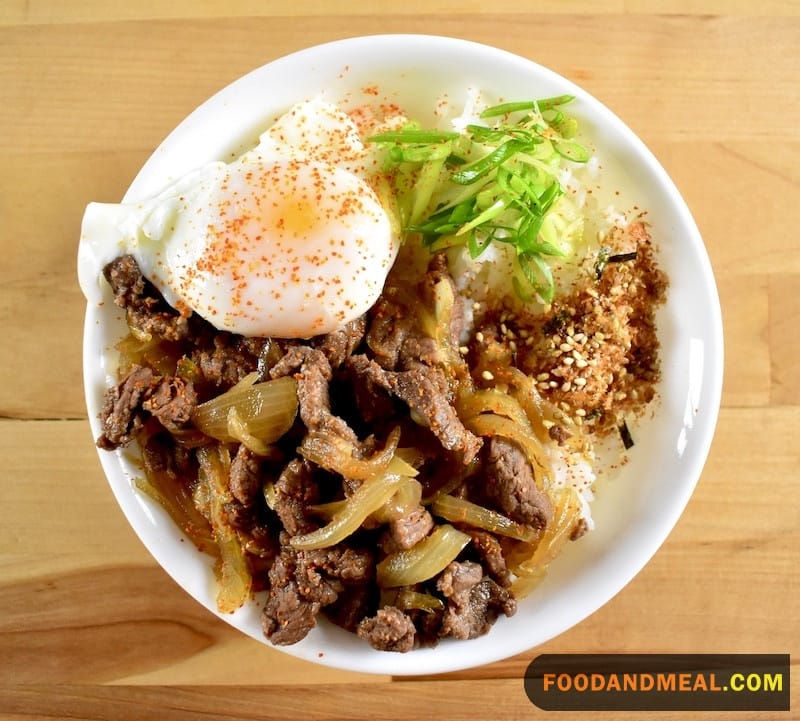
- What is gyudon sauce made of? Gyudon sauce typically consists of soy sauce, mirin (sweet rice wine), sake (Japanese rice wine), sugar, and dashi (Japanese stock). The combination creates a savory-sweet flavor profile that complements the beef and rice in Gyudon.
- What is the best cut of beef for gyudon? The best cut of beef for Japanese beef bowl is thinly sliced beef, such as sukiyaki or shabu-shabu beef. These cuts cook quickly and absorb the rich flavors of the sauce, resulting in a tender and flavorful beef bowl.
- What type of rice does Yoshinoya use? Yoshinoya typically uses a short-grain rice variety, like Japonica rice, to serve with their Gyudon. The sticky texture of this rice complements the Gyudon sauce and beef well.
- What is Hanabi gyudon beef Yoshinoya? Hanabi Gyudon beef from Yoshinoya is a special edition that may include unique seasonings or toppings. The term “hanabi” translates to “fireworks,” suggesting an explosion of flavors in this particular Japanese beef bowl variation.
- Can I make gyudon beef bowl with chicken instead of beef? Absolutely! While it won’t be “Gyudon” anymore, you can create a delicious “Toridon” by using thinly sliced chicken. Follow the same recipe with this substitution for a tasty alternative.
- Is there a vegetarian version of Gyudon? Yes, you can make a vegetarian Gyudon by substituting the beef with tofu or seitan. Use vegetable stock instead of dashi and adjust the seasonings to your liking.
- How do I store Gyudon leftovers? To store leftovers, place them in an airtight container in the refrigerator for up to 2-3 days. Reheat in a microwave or on the stovetop, adding a little extra dashi to maintain the flavors.
- Can I freeze it? Freezing Japanese beef bowls is not recommended, as it can alter the texture of the beef and onions. It’s best enjoyed fresh.
- What’s the origin of Gyudon? Gyudon is a popular Japanese dish that originated in the late 1800s. It’s known for its simplicity, affordability, and delicious umami flavors.
- Can Wasabi be Used in Gyudon Recipe for Extra Flavor? Adding a touch of unique heat, you can make wasabi at home to enhance the flavors of a traditional Gyudon recipe. Infusing a spicy, yet refreshing taste, a dollop of homemade wasabi offers a delightful twist to this beloved Japanese beef bowl dish. Explore the art of making wasabi at home and elevate the culinary experience of your Yoshinoya Gyudon beef bowl.
Conclution
As I reflect on my gyudon beef bowl journey from that first revelatory bite in Japan to developing my Southern-inspired recipe, I’m filled with gratitude. This humble beef rice bowl opened my mind and palate, inspiring creativity in my kitchen back home. It challenged me to bridge cultures and find connections through food that nourish both body and soul.
I hope my unique take on this iconic dish brings warmth, comfort and a little magic into your life as well. Gyudon Recipe Yoshinoya is so much more than just a meal – it’s a story of travel transforming into traditions we share with those we love. Thank you for letting me share mine with you today. Now go make some memories of your own!
I'm James F Anderson, a noted sous chef from London and a Le Cordon Bleu alumnus. My career began in a Michelin-starred Parisian eatery, where my blend of classic and contemporary cooking, using seasonal ingredients, earned accolades. Recognized in culinary publications and on cooking shows, I’m committed to mentoring aspiring chefs and delivering memorable dining experiences, marking me as a standout talent in the culinary world.

